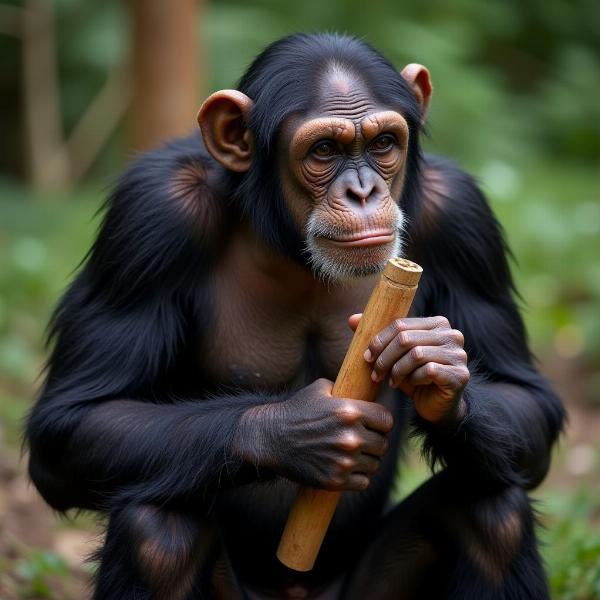Understanding the meaning of “anthropoid” is crucial for anyone delving into the realms of primatology, anthropology, or even science fiction. This term, often encountered in scientific literature and popular culture, refers to a specific group of primates, closely resembling humans in their physical characteristics and behavior. But what exactly does “anthropoid” translate to in Hindi, and what are its deeper implications?
What Does Anthropoid Actually Mean?
The word “anthropoid” originates from the Greek words “anthropos” (meaning human) and “eidos” (meaning form or shape). Therefore, “anthropoid” literally translates to “human-like” or “having a human form.” In biological terms, it classifies primates that share certain evolutionary traits with humans, such as a relatively large brain size, forward-facing eyes, and a reduced snout. This group includes monkeys, apes, and humans.
Anthropoid Meaning in Hindi: मानवाभ (Manavabh)
In Hindi, the most accurate translation of “anthropoid” is मानवाभ (Manavabh). This word, like its English counterpart, emphasizes the resemblance to humans. मानव (Manav) means human, and आभ (Abh) signifies resembling or like. Thus, मानवाभ accurately captures the essence of being human-like, reflecting the core meaning of “anthropoid.”
Delving Deeper into the Classification of Anthropoids
Anthropoids are further classified into two suborders: Platyrrhini (New World monkeys) and Catarrhini (Old World monkeys, apes, and humans). Understanding this distinction is crucial for comprehending the diversity within the anthropoid group.
New World Monkeys vs. Old World Monkeys: Key Differences
New World monkeys, found in Central and South America, possess prehensile tails, which act as a fifth limb, aiding in their arboreal lifestyle. Old World monkeys, inhabiting Africa and Asia, lack prehensile tails and exhibit a wider range of terrestrial and arboreal adaptations. This difference highlights the diverse evolutionary paths taken within the anthropoid group.
Why is Understanding “Anthropoid” Important?
The term “anthropoid” plays a significant role in various fields. In anthropology, it helps us understand human evolution and our relationship with other primates. In primatology, it allows for a more precise classification and study of primate species. Even in popular culture, the term “anthropoid” often appears in science fiction, referring to alien species with human-like characteristics.
The Significance of मानवाभ in Hindi
Using the correct Hindi term, मानवाभ, is essential for accurate communication and understanding within the Hindi-speaking scientific community. It ensures clarity and avoids potential misinterpretations when discussing this important primate group.
Anthropoid: Beyond the Physical Resemblance
While the term “anthropoid” primarily focuses on physical characteristics, it also has implications for behavior and cognition. Many anthropoids exhibit complex social structures, tool use, and problem-solving abilities, further highlighting their close relationship with humans.
 Anthropoid Behavior Example
Anthropoid Behavior Example
Conclusion
“Anthropoid,” meaning मानवाभ (Manavabh) in Hindi, refers to a group of primates closely related to humans, encompassing monkeys, apes, and humans themselves. Understanding this term and its implications is essential for anyone interested in primatology, anthropology, or even the broader scientific world. It provides a framework for understanding our place within the primate order and appreciating the diversity and complexity of the natural world.
FAQ
- What is the literal meaning of “anthropoid”? The literal meaning is “human-like” or “having a human form.”
- What are some examples of anthropoids? Examples include chimpanzees, gorillas, orangutans, baboons, and macaques.
- Why is the Hindi translation important? Using the correct Hindi term, मानवाभ, ensures accurate communication and understanding within the Hindi-speaking scientific community.
- How are anthropoids classified? They are classified into two suborders: Platyrrhini (New World monkeys) and Catarrhini (Old World monkeys, apes, and humans).
- What is the significance of “anthropoid” in anthropology? It helps us understand human evolution and our relationship with other primates.
- Does “anthropoid” only refer to physical characteristics? While primarily focused on physical traits, it also has implications for behavior and cognition.
- Where can I find more information about anthropoids? You can find more information in scientific journals, books on primatology and anthropology, and reputable online resources.
Related Articles
Meaning-Hindi.in is your one-stop solution for all your Hindi translation needs. We offer a wide range of translation services, from business and legal documents to technical manuals and educational materials. Our team of expert translators ensures accurate and culturally sensitive translations, catering to diverse clients across various industries. Whether you need business translation, legal document translation, website localization, or technical translation, Meaning-Hindi.in provides high-quality, reliable services. Contact us at [email protected] or call us at +91 11-4502-7584 for all your translation requirements.